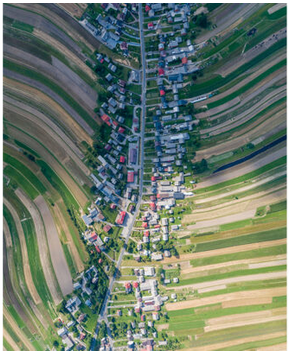In a world where urbanization often leads to sprawling cities and neighborhoods, the quaint charm of small towns and close-knit communities is a treasure for those who appreciate it. There’s something special about living in a place where everyone knows each other’s names, where the local bar serves as a gathering spot, and where life feels interconnected. But what if your entire town lived on a single street? This intriguing scenario is a reality for the residents of a European town that recently gained attention on Twitter.
The town in question is Suoszowa, located in southern Poland. It has earned the nickname “Little Tuscany” due to its unique design. What sets it apart is the fact that all 6,000 of its residents live on a single nine-kilometer street. An aerial photograph of this extraordinary community went viral on social media, sparking curiosity and wonder.
According to data from CSO Poland, Suoszowa had 5,819 residents as of 2017, and the population may have grown since then. Each home on this remarkable street comes with a substantial strip of land, allowing residents to engage in various activities like farming and keeping animals. The aerial images capture the beauty of this arrangement, with fields of different crops creating a vibrant patchwork of colors.

Residents of Suoszowa have shared their affection for their unique community. One local commented on the charm and atmosphere of the place, expressing a strong preference for their way of life. Another explained how the homes and adjacent strips of land create a visually captivating landscape, with each household using their land for different purposes, be it crops or animals.
The question of land ownership and land use was also discussed online. One response from a Polish resident confirmed that each house indeed has its strip of land, and the residents employ these plots for various purposes, resulting in the colorful diversity visible from above.
Suoszowa’s unusual setup is indeed a sight to behold, challenging conventional notions of what a village or town should look like. Its remarkable cohesion and shared space present an intriguing way of life that stands out in a world of sprawling urban landscapes. It’s a testament to the human capacity for adaptability and community building, and it has captured the fascination of people around the world.
